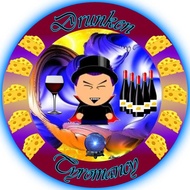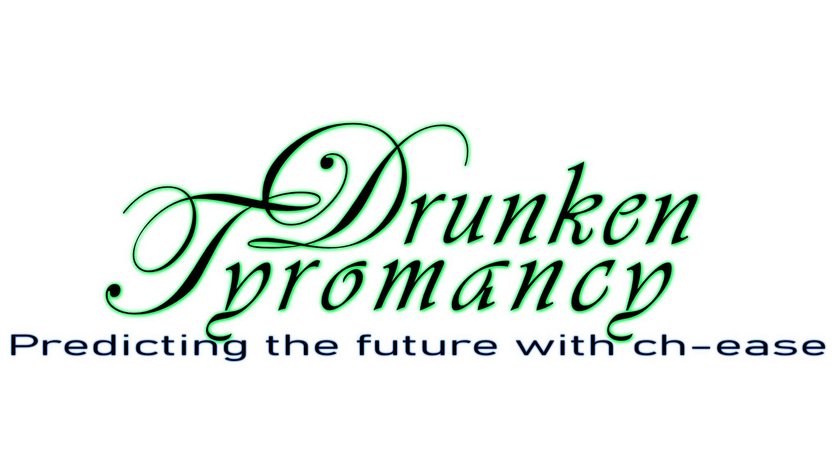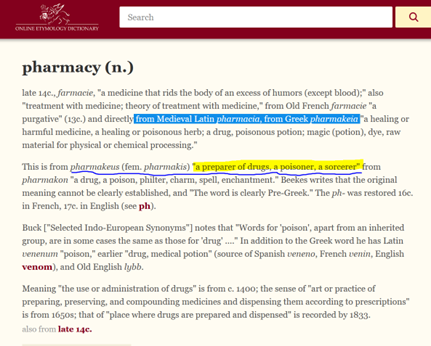REMEMBER:
All project resources present and future are detailed here:
• Locals: drunkentyromancy.locals.com/post/5323758/welcome
I will update this welcome document and video in the future to make it a single article, but only after I have actually started using more of those publishing sites.
Support this Project:
• BuyMeACoffee: buymeacoffee.com/drunkentyromancer
Current publishing:
• Substack: thedrunkentyromancer.substack.com
• Rumble: rumble.com/drunkentyromancy
• YouTube: youtube.com/@DrunkenTyromancer
• Telegram: t.me/drunktyro
Video uploads here:
• YouTube: youtu.be/OYxc7p76RfU
• Rumble: rumble.com/v4l59df-introducing-the-encyclopaedia-tyromancia-playlist.html
• VK: vk.com/video579391090_456239033
Introducing the Encyclopaedia Tyromancia:
I have decided to give myself a bit of a focus for making videos when no other ideas come to mind, and which will constitute a playlist you can follow as I add content to it over time.
The Encyclopaedia Tyromancia will be a bunch of articles and corresponding videos in which I look at the meanings of words, their etymology, and significant differences to the meanings of other words which are often taken as being at least partially synonymous (whether that be true or false).
The main purpose of this playlist will be to correct the record, and provide a common baseline of semantic understanding between you the audience and myself the author, so that I can refer to such words in other content, and if you have watched or read the corresponding Encyclopaedia Tyromancia content, you will know what I mean and what I do not mean, without me needing to repeat myself and prove the point again.
Hence, this won’t just be about the meanings of words and the structure and rules of language itself, but also about how this relates to the conceptual worlds of philosophy logic and semantics as applied principles.
General Concepts:
In this first introductory article and video, I want to talk to you about those kinds of background rules and principles which will affect every word we wish to define and understand. So let’s begin by talking about the most important central themes of the topic:
• A Lexicon (set of words making up a language - the dictionary if you will)
• Semantics (meaning) & etymology (origin & history of meaning)
• Synonyms, redundancy, and semantic hierarchy
Character Sets, Words, Lexicons, & Lexicography:
So the first concept to get into your head is that a language is comprised of a character set, which may or may not have sub-sets, for example, the total character set of English uses the alphabet, plus optional inflections to aid understanding of pronunciation, and you could also add other things like the numerical characters which allow us to write numbers without fully spelling the name of each).
This character set follows some fixed and flexible ‘rules’ to form valid ‘words’ in that language, and these words are the elements in the lexicon as a set. Your vocabulary is therefore a subset lexicon of the total available words of your chosen language, and if you listed all the words used to write a book, that would be the lexicon of that book.
Lexicography is therefore the study of any lexicon, the study of lexicography itself, and the art/science of writing down a lexicon into a dictionary, which would make you acting as a lexicographer when you are engaged in that process.
What you should notice above is the use of various prefixes and suffixes to modify the root word, in order to identify the set of variations which describe all things we might want to do with this word - so:
• Lexicon (the root word - a noun)
• Lexicographical (something of a Lexicon in its nature - an adjective)
• Lexicography (the field and study, or applied art/science, of things lexicographical in nature - both a verb and a noun, making it a sort of ‘gerund’)
• Lexicographer (someone who does or is doing lexicography - a noun)
So, understanding a lexicon requires understanding things that make up the words within a lexicon, such as prefixes, suffixes, syllables and so on.
Semantics & Etymology:
Where semantics is meaning itself for any word of any lexicon, etymology is the history and origin of that meaning, but as we will see in the next section, this etymology, and particularly the historical usage of words, cannot be taken as the prime root semantic source above all others, and I will explain why with some examples.
But first, just understand that semantics is about meaning, and etymology is about where that meaning comes from - so for any prefix, suffix, whole word, and sometimes other syllabic components, there will be some source of meaning, which you can enquire about through etymology, then apply to your semantic understanding of the lexicon.
However the reason I wrote the preceding caveat, is just to alert you to the pitfalls I will describe next, and which arise from the same problem brought about by the internet, wherein past academic guardianship of the language has been lost, and replaced by the profit motive to have the most profitable online dictionary or encyclopaedia, and as you can imagine, that profit often comes from people with ideological agendas who do not care a tinker’s cuss about the sanctity and preservation of the language itself, nor indeed would they even understand where they have breached it, and what the consequences are.
So while yes you can go to various online sources, be very critical of what you read, because even those which remain connected to some kind of academic institution, suffer some of the same problems as all the cheap and nasty ones people just made for money.
Synonyms, Redundancy, & Semantic Hierarchy:
The term redundancy made its way into this, simply because it is an easy example to give you which demonstrates the point I want to make, but it is not the only place where this whole thing goes wrong, so I will allude to and explain as many others as I can think of while I write, and perhaps you will discover more for yourself.
So a synonym for another word, or a set of words that are synonymous, means they are words which - according to a common definition I am about to disagree with on one subtle point of difference - have exactly or almost exactly the same meaning, and herein my disagreement comes down to the interpretation of that second part, because it has allowed people to use words as synonyms where I think it would be more accurate to say only that they are related and loosely similar, but not actually synonymous, thus giving rise to the need for this concept of a semantic hierarchy.
To explain this will take a little effort, so be patient, because I want to be absolutely certain to state this very carefully, so you can see why it must be taken as true, especially if our goal is to act as guardians of the language.
Now, for every word which is a contextually specific application of a root word, but with a slightly different meaning than other contextually specific applications of the same root, we can obviously take these as definitely being synonyms, as they do not need to exactly match each other’s meaning necessarily.
An obvious and readily apparent example of this, is where we can look at the word contract - whereby:
• From Latin root meaning: "to draw objects together; draw in, …, or abridge"
• Hence one synonym of this root, is the contextually specific usage where a person believes they have “contracted a cold or flu” - meaning that: they believe they have been “brought together” with something causing the development of symptoms
• Another synonym here is the usage in business, where we sign a contract for goods or services to be provided from one party to another in the terms of the contract, and thus the contract “brings together” the people, goods, and/or services
So it is easy to see how these two things are loosely synonymous, yet different contexts - they are not interchangeable because of the difference in contexts, but then how would you know the difference, as they are also homophones (sound the same), homographs (in the sense they are spelled the same), and perhaps (?) homonyms, in the sense that the contextual meaning is not actually identical.
So we could have a philosophical debate about which category exactly to put them in, depending on how you look at it, but the important thing here is only to understand that it is not as simple as you think. Specifically above, a business or legal contract is a noun, but to contract a disease is more so a verb, so this would allow you to argue they are fully homographs if we accept the definition that a homograph only has the same spelling but a different meaning.
Personally I do not like to use such an interpretation of homograph as being only both same spelling and different meaning, as the word itself literally translates as “one/unified form” and says nothing at all about the meaning or sound attached to that form and its expression, while homophone translates as “one/unified sound”, saying nothing about spelling (form) or meaning (semantics), and homonym would be best translated as saying “one/unified name” thus specifically referring to form, where a ‘name’ is a label placeholder for the thing that label points to (semantics/meaning).
So I would argue that homonyms are homographs, but synonyms might also be homographs, while homophones are not necessarily homographs, but they could be in some cases, especially if we consider the subtle and more distinct differences between meanings, and again it comes down to a bit of a philosophical debate as to whether or not any homophone is actually synonym or not for those borderline cases, and what is important really is asking the question WHY do you want to know? The answer to which, may mean that we change our perspective on how to classify words for different scenarios.
Redundancy:
Thus we come across this issue of redundancy, because once we decide how we are going to interpret these things, one of the next things we will find is that there are many things taken to be synonyms, but which, used in such a manner, create an absolutely useless redundancy in the language, and this is a good indicator that the meaning being ascribed to one or more words in the synonymous set, are incorrect or in some way misleading.
Once you discover a redundancy, there are usually other indications via usage, which confirm the fact that one or more ascribed meanings are incorrect. An easy example of this being the words “annihilate” and “decimate”, where they are commonly used incorrectly as synonyms, but their true meanings are very different, albeit related, and do not qualify as valid synonyms, thus it is an incorrect usage - as follows:
• Annihilate means to destroy utterly or near utterly
• Decimate means to destroy 1/10th (or just loosely some small but significant proportion)
The latter term comes from the practice of the Roman Empire to enter a village and kill 1/10th of the population, as a means to quell potential unrest and keep the people in fear of ever daring to rise up against the Romans, but it is commonly used in place of annihilate, which cannot even loosely be used to mean the same thing, because it doesn’t, you are changing the meaning, and creating a total redundancy.
The problem here is that we have two non-homographic words, which, if used as synonyms, lose any difference, and those debilitate the lexicon by losing meaning, and gaining a useless redundancy, none of which would ever win an academic debate on the correct usage of language, as it provides no value, but does cause a loss.
Sometimes this problem is simply caused by poor education, other times by poor thinking, or a failure to think at all, and at other times it is caused by deliberate agenda - ie: to change the meanings of words in common usage, in order to achieve some kind of political objective.
Semantic Hierarchy:
This one can be further clarified by thinking about the historical origin (etymology) of meaning (semantics) in the light of the concept of mistaken identity, and I use this example specifically to point out where the first usage of a word should not be taken as the root of any semantic hierarchy, just because it is the oldest. The example I will provide is a little weird, but it demonstrates the idea perfectly, which is why I am going to use it.
Imagine if you will, an early primitive people, whom, in their culture, had very little if anything in the way of science, but they were particularly superstitious, and it was from their culture and language we may have gained a word such as ‘horse’ to describe some particular mammal they came across at some stage.
Now, in their world of supernatural beliefs, they decided that a horse was a spirit of some kind of god they happened to believe in, and that it wasn’t really “of this material world” entirely, so this becomes their understanding of the meaning of ‘horse’. Now, does that mean it is true that this is what a horse is, just because they believed it, and thus this is the semantic we should apply? I hope you can see why the answer is an obvious no … we are not arguing whether or not by some supernatural phenomenon they may actually have been right, we are simply identifying the fact they had no reason to believe it, they just made it up, and so we have no reason to believe it either … what matters here is that there are other discoveries since their time, and which we can use to identify things that are true about horses, and thus the label ‘horse’ is a pointer to many things, but its root meaning is not the earliest meaning used, since we have no reason to believe they had correctly identified the object they were naming.
The other thing we want to see then is how history does become the root of the hierarchy, such as in the previously explained example using the word ‘contract’, or looking at the root semantic for the Latin prefix ‘deci-’ in the word ‘decimate’, and in such cases, we will use that historical etymology to define the most generic possible meaning as the semantic root for the hierarchy of all synonyms.
Another aspect of the semantic hierarchy is looking at variations of a word to identify the simplest application of it - eg: ‘lexicon’ can be treated as the root for lexicography, lexicographer, and lexicographical - now, as far as I know, there are no homonyms of the word lexicon, but for other words, we will find that they do have such homonyms, and every homonym, having a different meaning, must therefore be taken as existing in some other semantic hierarchy, though perhaps thanks to the common meanings of prefixes, suffixes and other syllables, there may be some component crossover between these hierarchies.
I will include this kind of analysis in many words of the Encyclopaedia Tyromancia articles and videos, in order to be clear as to what it teaches us about the word, but also what it teaches us about reality, the way in which it has been used, particularly how it may have been inadvertently misused, thus causing common misunderstandings amongst people discussing any topic in which the word was a significant part of the discussion, and where it has been misused quite intentionally, for the express purpose of deceiving us.
Conclusion:
So that’s the gist of things, and if you are interested, this playlist on Rumble YouTube & VK will allow for some interesting topics to be discussed and clarified.















